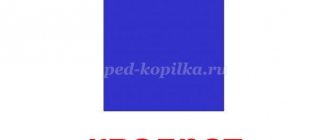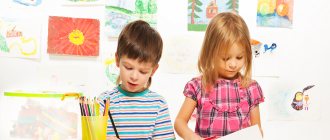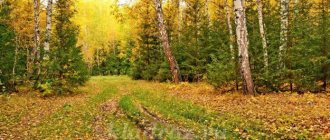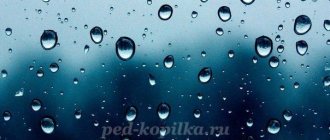Simple applications of geometric shapes for little ones
Crafts, souvenirs and mosaic applications of geometric shapes are ways to engage your child in useful practice. Participation in joint activities is a guarantee of high aesthetics of work, where children perform the feasible part of the task. This develops imagination and imaginative thinking.
Important! When teaching small children to work, pay special attention to the safety of the tool.
- Scissors don't have to be dangerous. There are special children's scissors for working with paper. They are distinguished by rounded ends and plastic tips that cover the outer part of the instrument. In any office supply store, the seller will show you what you need. Before work, you need to make sure that the blade is sharp enough to work with paper, the screw provides freedom, and the format is convenient for children's hands.
- Colored paper is the basis of geometric appliqué. It is sold in A-4 format packages. Additionally, white office paper, napkins, a “reaper” and foil on a paper backing are used. Colored cardboard is suitable as a background. Occasionally, scraps of wrapping paper and other pliable materials can be used for the work of children 6–7 years old.
- Glue is the main way to connect applique fragments into a single image. The composition and packaging are selected according to the age characteristics of the children. A glue stick is more suitable for kids; older children need to learn to work with a brush or the narrow spout of a PVA bottle.
Note! Any adhesive quickly dries or polymerizes. Before use, check the adhesiveness. At home, if you don’t have silicate glue or PVA, you can make a paste from flour or dilute a little dry mixture for wallpaper.
A carefully executed “fox” or “cat” appliqué made from geometric shapes requires patience from adults, and perseverance and consistency from children.
If children are interested and provided with everything they need, including safe tools, completing the task will be a lot of fun.
Geometric applique ideas for preschoolers
The world around us is an inexhaustible treasure trove of ideas for children's creativity. Many images can be made from circles, triangles and rectangles of different colors and sizes.
A simple task with varying green shapes - tree caps of different shapes. It is easy for adults to cut out a brown trunk with some branching, and children can attach different green figures that will symbolize the crown.
This experience can be used to form compositions from geometric figures.
Funny animals and their cheerful faces, natural phenomena, houses and cars, airplanes and rockets are good topics for geometric applications. The older the children, the more difficult the creative part of the task should be.
They must learn to form different figures from the same fragments, which can be cut into pieces or in half.
Transport
It can be difficult for young artists to draw technical objects - tanks, ships, cars. It is much easier to make a “car” appliqué from geometric shapes than to draw it with paints or a felt-tip pen.
The very process of selecting the necessary “parts” from which a bus, truck or car is built is interesting.
Helpful advice! Let the children choose which option they would like to make using geometric circles and rectangles.
For the truck that the boys like to make, you will need 2 rectangles (body), a light square (cab glass), 2 large circles (tires) and 2 smaller black circles (wheels).
Understanding that everything in the world around us consists of individual elements is an important part of the educational process. If children are able to cut out the necessary components themselves, adults will need help in determining the order of “assembling the car.”
Animals
It is easier for children to make flowers or grass than to make a face. Some images consist mainly of a torso and head, and are much easier to make than “animating” animals.
So that the child is not afraid of difficulties, suggest assembling a fox figurine from geometric shapes - an applique of triangles:
- Two large orange triangles are the head and body of a fox cub.
- To design the face you need 2 orange elements (ears), 1 black (nose) and 2 white (eyes).
- The tail consists of orange and white halves.
- Another 1 white triangle will decorate the animal’s chest.
You can complete the pupils of the eyes or leave them as is. The fox can be seated on the grass, autumn meadow or snowdrifts.
Important! If you replace the color of the triangles and several elements, use the same method to make a puppy or cat. Faces can be “revitalized” with a felt-tip pen.
Flowers
A favorite theme for all girls. The task of completing the applique in 2nd grade is proposed to be differentiated - offer flowers to girls and cars to boys.
Schoolchildren already have skills in working with colored paper. Therefore, it is better to offer them a difficult task - a three-dimensional applique of geometric elements in the form of a flower arrangement.
Rocket
Children are often asked to perform this flying object on the eve of Cosmonautics Day. A preschooler himself is able to lay it out from several geometric shapes:
- 3 triangles;
- 2 circles;
- 3 squares.
The color can be varied or selected in accordance with the proposed sample. Connecting the elements together and gluing them together is not difficult. The hidden complexity lies in the symmetrical (mirror) connection of triangles and the overlapping of squares, symbolizing the separate parts of the rocket.
Lesson notes for educators and teachers
Topic: Geometric shapes
Goal: To consolidate concepts about geometric shapes. Summarize knowledge about the properties of shapes
(color, size). Strengthen ordinal counting within 10. Enrich your vocabulary.
Develop logical thinking, tactile and long-term memory, proper breathing, listening skills, fine motor skills.
Cultivate accuracy and self-control.
PROGRESS.
Psycho-gymnastics.
-Look how many guests have come to us, say hello to the guests. -Sit more comfortably on a chair, close your eyes and listen - how is it in our office? Quiet or loud?
-Now close your eyes and listen to what is happening behind the door. - Loud, why loud?
-Someone is knocking on our door, someone is probably late for our lesson. Let's invite a guest.
-Look, this is a box, what geometric shape does the side of the box resemble? And this?
A box with something written on it. -Let's read it! Can you help me?
- Parcel for Maxim.
- Who is Maxim? So this is for you. Let's see what's inside it. -This is a package of tasks and we need to complete them.
Envelope No. 1
-There are geometric shapes in the envelope, name them.
-Using the same figures, you can create new geometric
figures.
-Attach these figures first. Then, without looking into the bag, by touch find the figures that I will name.
-Well done, you completed the task! Let's move on to the next task
-Take the envelope with the number 2 written on it.
Envelope No. 2
-What do I have? This is a frame. What shape is it? What geometric shapes does it consist of?
-Now we will make a square from different figures. What color is the square, what shapes did you make it from, how many corners, how can I say it differently?
- Well done, you did it. Let's put our squares in the parcel.
-Now what number is the next envelope?
Envelope No. 3
-Look what's in the envelope? We need the lace for the next task.
-After all, with the help of geometric shapes, you can not only create new shapes and assemble the shapes themselves using different ones. But the objects of our life themselves symbolize geometric shapes. Now, we need to match the figure with the object using laces.
-Well done! Let's move on to the next task. Envelope with number 4
Envelope No. 4
-What is this? What do we need the tube for? You can also breathe into it.
-You will blow into the tube so as to roll the ball to the top and hit
hole.
Envelope No. 5
-Here we have drawn figures, you need to draw them with the help of a ball, but at the same time close your eyes.
-Well done!
Envelope No. 6
-We have a marker. And we need to solve examples.
-I really liked the way you solved the examples.
-Let's see what we have in the next envelope under the number 7
Envelope No. 7
And we have geometric shapes. Tell me we can make something out of
these figures. Build what you want.
What or Who did you depict? What else can be built?
And what's in the last envelope? What number...
Envelope No. 8
And here is a cutaway picture. Let's collect it. And we will have the task on the computer.
- Help the car get to the house by choosing the correct path from the shapes
- Help the car get to the house by choosing the correct path by color.
- Look at the lights of the house and remember them. Now put them the way they were for me.
4. Tell me what time of year it is? It's cold outside and icicles will appear soon. I already have icicles, I just need to paint them.
Result: name the figures we talked about. Which group can we unite into? What is another name for them? What are these figures?
Maxim, look at our parcel - it has become a great parcel of your knowledge.
Source: https://konspekty-zanyatij.ru/uchebnye-materialy/konspekt-zanyatiya-po-femp-v-starshej-gruppe-geometricheskie-figury/




